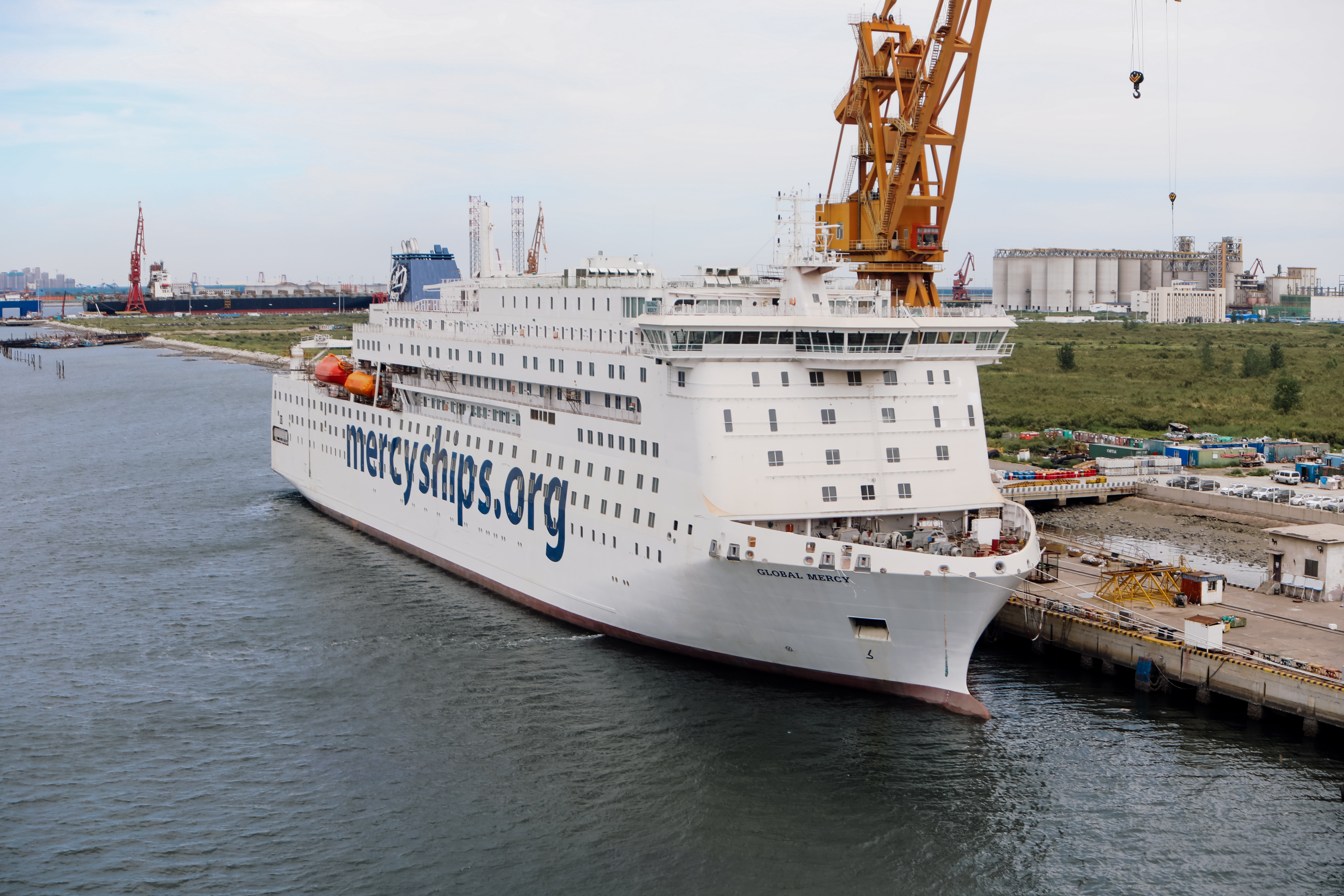AV Central to Floating Hospital’s Operations
Global Mercy Uses Technology to Enhance Communications

With more than 5 billion people lacking access to safe surgical care and 50 percent of the world’s population living near a coast, the charitable organization Mercy Ships uses its fleet of hospital ships to increase access to state-of-the-art medical care worldwide. Transforming lives by serving one nation at a time, Mercy Ships began its work in 1983 with the launch of the Good Samaritan hospital ship, which provided care throughout the Caribbean, Central America, and South America for 11 years.
Mercy Ships currently has one ship in operation, the Africa Mercy, which launched in 2007 and provides services throughout Central and Western Africa. With the need for their services continuing to grow, Mercy Ships wanted to build on the work of Africa Mercy, which is able to perform approximately 7,000 interventions a year, and expand their fleet by building another ship of equal or greater capacity.
With that in mind, Mercy Ships has taken ownership of the newly constructed 37,000 GRT (gross registered tonnage) hospital ship Global Mercy, which will double Mercy Ships’ current capacity and will offer increased training opportunities for their crews. Over the expected 50-year lifespan of the ship, Mercy Ships estimates that more than 150,000 lives will be improved through surgeries alone. Mercy Ships is able to provide these services with the help of more than 1,300 volunteers from over 50 nations who work anywhere from two weeks to two years, and whose skills and specialties include medicine, operations, AV, and other areas.
When fully in operation, the ship will hold up to 950 people. Hospital functions will be contained to decks 3 and 4 and will cover approximately 75,350 square feet (or 1.3 football fields). Medical facilities will include six operating rooms, 102 acute care beds, seven ICU isolation beds, and 90 self-care beds. This area will also include meeting rooms and conference spaces that will help the crew to conduct in-house training sessions. Meeting spaces were designed based on crew feedback and experience.

Since the ship is a brand-new build, Mercy Ships has focused on installing the newest technologies on the market. “As a new ship, we were able to design it from the ground up to meet our exact needs instead of retrofitting one,” said Jonathan Dyson, director of enterprise infrastructure for Mercy Ships.
The health organization partnered with North Star Engineering, which served as the overall technology consultant for the new ship. The QSC Q-SYS Ecosystem of audio, video, and control solutions will serve as the main AV platform aboard the Global Mercy. This network-driven solution will allow each location within the ship to be controlled internally, or remotely from Mercy Ships’ headquarters in Lindale, TX. The platform will help manage the shipwide P.A. system, as well as AV and control for meeting rooms, café areas, hospital training rooms, and the auditorium. It gives Global Mercy the ability to integrate PTZ cameras, microphones, control panels, speakers, and amplifiers through a software-based centralized control interface. Overture by Barco is being deployed to control and manage equipment in the meeting/conference rooms and auditorium.
“Improving technology within the organization has always been at the forefront of our minds within the technology group. However, it is a constant balance between being conscious of the funds our donors provide and the benefits we see available in emerging technologies,” said Dyson.
A daily selection of features, industry news, and analysis for AV/IT professionals. Sign up below.
These technology integrations provide functional tools to empower the volunteer crew to perform their work efficiently. Technology also keeps the crew connected to those back home and colleagues aboard the ship during their time at sea, helping them collaborate and administer fast and effective care to their patients. “With better communication, our staff is able to work internationally with different offices and support teams, providing much better care for patients who board our ship,” Dyson added.
Shipwide P.A. System
The ship’s wide area public address system is able to span 11 decks of the Global Mercy thanks to the Q-SYS Ecosystem by QSC. Q-SYS’ Core 510i processor sits at the ship’s AV helm, controlling 20 CXD-4.3Q network amplifiers that in turn power 100 QSC AD-C6T-LP loudspeakers. The crew relies on three Q-SYS PS-1600H paging stations for shipwide communications. The full-featured Q-SYS control engine within the Core processor gives Global Mercy teams complete control of the audio setup, giving them the ability to route audio sources to multiple locations throughout the ship.
“QSC is honored to work with Mercy Ships to provide technology—including our Q-SYS software-based audio, video, and control ecosystem—to further enhance the ship’s capabilities and create a floating work environment where users can quickly and easily collaborate,” said Anna Csontos, executive vice president, chief market officer and chief of staff at QSC. “Mercy Ships is a wonderful organization, and we are proud to contribute to such a wonderful cause.”
Conference Rooms
The Global Mercy will have 10 conference/meeting rooms, each set up using the QSC Q-SYS Ecosystem. Each room will be configured with NEC displays, QSC PTZ conference cameras, a QSC Q-SYS Core 110f processor, Q-SYS TSC-7w Network Touch Screen controllers, and QSC in-ceiling loudspeakers with Audio-Technica ceiling microphones. These integrations will give the staff the ability to conduct presentations and video calls, and help them connect with staff and experts around the world.
[The Technology Manager's Guide to Conference Rooms]
Auditorium
Giving staff the ability to hold meetings, seminars and presentations with the entire crew, the 682-seat auditorium will be fitted with a separate audio reinforcement system, but the room will still use QSC Q-SYS Ecosystem. The auditorium will feature an Allen & Heath QU32 digital console, QSC CXD4.3 and QSC CXD4.5 amplifiers, QSC WL3082 Wideline 8 with QSC WL212-sw subwoofer, QSC AP-5102 high-power loudspeakers, and QSC K12.2 powered loudspeakers.
The room’s lighting system will include a Martin M2GO HD lighting control console, and Rush MH 6 Wash, Rush MH 1 Profile Plus, and Rush PAR 2 Zoom lights from Martin by Harman. Sony EVI HD-1 cameras will be installed to enhance overall presentation capabilities.
AV Gives Back
Technology providers including Barco, NEC Display Solutions of America (now Sharp NEC Display Solutions), Peerless-AV, and QSC also chipped in to provide donated and/or discounted products.
Mercy Ships relies almost entirely on volunteers and donors to accomplish its mission, according to Bobby Baker, head of corporate relations at Mercy Ships.
“For Peerless-AV to be able to help out by donating products that we manufacture was the least we could do to give back to this amazing organization that brings lifesaving medical treatment to those in need around the world,” said Nick Belcore, executive vice president, Peerless-AV, whose company provided over 1,000 mounting solutions for Global Mercy.
NEC Display donated more than 2,000 commercial-grade displays for the vessel that were used in the meeting/conference rooms and auditorium. “Mercy Ships matches NEC’s vision of ‘Orchestrating a Brighter World,’” said an NEC Display spokesperson when the donation was announced. “With this partnership, we’re helping Mercy Ships achieve its goal of bringing hope and healing to those who need it most. The technology we’re providing is all commercial-grade, so it will provide lasting value for Mercy Ships, and in the end will create value for society as a whole.”
“NEC has really gone beyond the call of duty with its gift, and as a result of like-minded companies, we are able to bring state-of-the-art healthcare to parts of the world that need it most,” Baker added. “We’re all about bringing dignity to people and giving others the opportunity to contribute in meaningful ways. When you can restore sight to a child with a 15-minute cataract removal surgery, it’s a powerful thing. Our donors make this possible.”
Mercy Ships also relies on volunteer AV and IT professionals to keep its ships running. The organization is currently looking for a minimum commitment of three months for volunteer positions including AV technicians and service desk analysts.
To learn more about volunteer opportunities, visit mercyships.org/volunteer.
Time to Set Sail
Mercy Ships expects Global Mercy to be ready to receive patients this spring, and the ship is scheduled to begin its first voyage in Africa by late 2021. With the focus on technological enhancements centered around overall ship communication and meeting rooms, time will tell if further enhancements will be needed and requested from the hospital and operations units once the ship is up and running.
One thing is certain, however: technology plays a foundational role in the mission-driven work of Mercy Ships. Dyson concluded, “Mercy Ships has always been about bringing hope and healing to the world’s forgotten poor. While technology is not a highlight, it provides us with a necessary foundation and vehicle on which we can stand to provide that hope and healing, the ‘leg up’ for those we serve.”
Jennifer is a freelance writer and marketing consultant based in the New York City area. Within the AV industry, Jennifer loves to explore how technology can alter the world around us, creating immersive experiences unlike any other. She has years of experience working with AV integrators, manufacturers, and event production companies in developing engaging content to increase their overall awareness.

